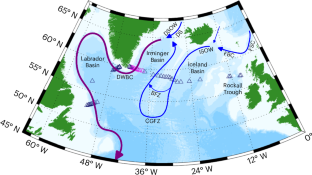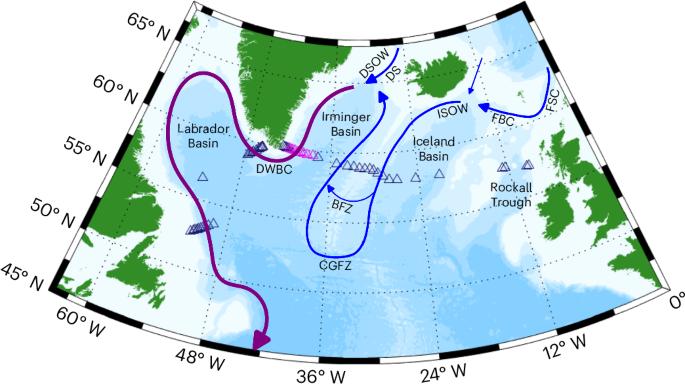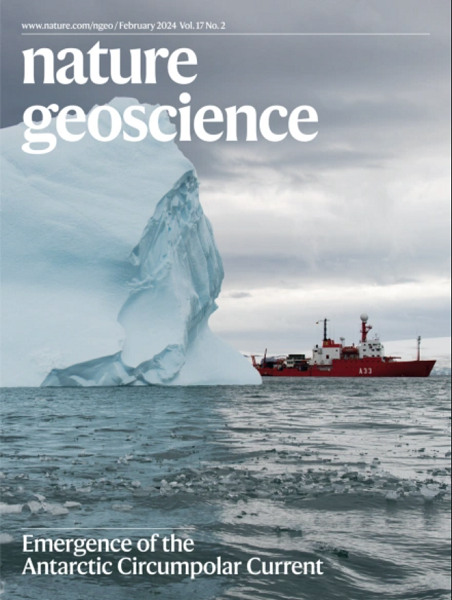观测到北大西洋副极地深层西边界洋流湍流减少
IF 15.7
1区 地球科学
Q1 GEOSCIENCES, MULTIDISCIPLINARY
引用次数: 0
摘要
大西洋经向翻转环流下缘是地球气候系统的一个重要特征,因为它将最近排出的海水送回深海,是人为碳的一个主要汇。深西边界流--下缘的主要组成部分--沿格陵兰岛东侧向南流动,输送在北欧海域形成的高密度海水。自 2014 年以来,深西边界流一直在该地点通过系泊阵列进行持续监测,以观察其源头附近的流速和水文结构。在此,我们发现,在最初六年的观测中,深西边界流的传输量减少了 26%,原因是:(1) 传统定义的深西边界流层(σθ > 27.8 kg m-3)变薄,而这一变薄来自于通过副极地地区传播的已知清新信号(56%);(2) 速度减弱(44%)。尽管速度减弱,大西洋经向翻转环流在同期却保持相对稳定。归根结底,这种差异是由于界定这两种环流的方法不同造成的。在两个看似相互依赖的环流中发现如此明显不同的趋势,这就提出了一个问题,即如何最好地定义这些输送。本文章由计算机程序翻译,如有差异,请以英文原文为准。


Observed decrease in Deep Western Boundary Current transport in subpolar North Atlantic
The lower limb of the Atlantic Meridional Overturning Circulation is an important feature of Earth’s climate system as it returns recently ventilated water to the deep ocean and is a major sink for anthropogenic carbon. The Deep Western Boundary Current—the primary component of the lower limb—flows southwards along the eastern flank of Greenland transporting dense water formed in the Nordic seas. Since 2014, the Deep Western Boundary Current has been continuously monitored at this location from a mooring array to observe the current’s velocity and hydrographic structure close to its source. Here we find that the Deep Western Boundary Current transport has decreased by 26% over the first six years of observations, due to (1) a thinning of the traditionally defined Deep Western Boundary Current layer (σθ > 27.8 kg m−3) from a known freshening signal propagating through the subpolar region (56%), and (2) weakening velocities (44%). Despite this decrease, the Atlantic Meridional Overturning Circulation has remained relatively steady over the same period. Ultimately, this difference is due to the methods used to define these two circulations. Finding such notably different trends for two seemingly dependent circulations raises the question of how to best define these transports. The amount of water transported southwards by the Deep Western Boundary Current shows a 26% decline since 2014 in mooring array monitoring data, despite the strength of the Atlantic Meridional Overturning Circulation remaining stable.
求助全文
通过发布文献求助,成功后即可免费获取论文全文。
去求助
来源期刊

Nature Geoscience
地学-地球科学综合
CiteScore
26.70
自引率
1.60%
发文量
187
审稿时长
3.3 months
期刊介绍:
Nature Geoscience is a monthly interdisciplinary journal that gathers top-tier research spanning Earth Sciences and related fields.
The journal covers all geoscience disciplines, including fieldwork, modeling, and theoretical studies.
Topics include atmospheric science, biogeochemistry, climate science, geobiology, geochemistry, geoinformatics, remote sensing, geology, geomagnetism, paleomagnetism, geomorphology, geophysics, glaciology, hydrology, limnology, mineralogy, oceanography, paleontology, paleoclimatology, paleoceanography, petrology, planetary science, seismology, space physics, tectonics, and volcanology.
Nature Geoscience upholds its commitment to publishing significant, high-quality Earth Sciences research through fair, rapid, and rigorous peer review, overseen by a team of full-time professional editors.
 求助内容:
求助内容: 应助结果提醒方式:
应助结果提醒方式:


